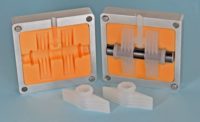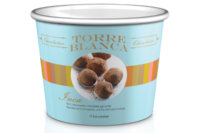Sheet processing technology benefits molders looking for a competitive advantage

PET sheet is an essential material in many food-packaging applications such as baked goods, yogurts, produce, meats, cheeses and deli. In addition, other industries, including electronics, toys, personal hygiene and consumer goods have found PET sheet to meet their needs in packaging applications.
However, there are differences in the manufacturing processes of some PET sheets compared to others. The main difficulty in the extrusion of APET sheet lies in the traditional manufacturing process that typically requires the use of granulated resin from a third-party supplier. After delivery from this supplier, the resin needs to be dried in a four-to-six hour energy- intensive operation before being fed into the extruder. From there, the extruder compresses and heats the resin into a melt, which is then transferred to the die and onto the rollers to form the sheet.
The new unique direct-to-sheet process (DPET™) from OCTAL (www.octal.com) eliminates five energy-intensive stages of the conventional sheet production process (pelletizer, SSP, compactor, dryer and extruder). Now the PET melt can arrive at the calendar stack heated to the proper temperature, so it does not have to be dried and re-melted from the granular form.
Thermoformers should note that this means there is no chance for contamination to enter the system. It ensures a finished polymer that is fully devoid of moisture, thus thermoformers see an elimination of all moisture defects. There is absolute traceability as the resin is constrained to one source - providing origin of the resin and quality. Food processors and packers can now be assured of product purity.
In addition, the uniformity of the sheet allowed OCTAL to design a winder that constructs precision rolls with unnoticeable weave and near perfect formation. Thermoformers benefit from this advantage by being able to minimize side trim, a direct material savings.
Gauge consistency in conventional PET sheeting is in the 3% to 8% range, with 5% as an average. DPET, on the other hand, is manufactured to a typical caliper variation of +/- 1%. Operationally, this outstanding consistency allows thermoformers to specify a thinner sheet and still achieve package performance in finished trays.
DPET’s direct-to-sheet process results in a material with superior clarity and gloss. The DPET surface also allows for subsequent printing processes to allow for high-impact merchandising.
DPET can be run at a 10% faster cycle time, and at temperatures up to 5° lower than conventional APET, while still retaining clarity and gloss. This translates directly into lower electricity and overhead costs per finished unit.
DPET has excellent flow characteristics, resulting in 3% to 8% more material reaching inside corners of mold profiles. Combined with an intrinsic viscosity of 0.78, and the implication is, that finished containers are tougher, more resistant to cracking, and better able to withstand the rigors of shipping to retailers and end users. Its high intrinsic viscosity also means less scrap and skeletal waste.
“As OCTAL establishes itself as the market leader in PET sheet, more and more thermoformers are finding that DPET’s physical properties translate directly into competitive advantages for both the thermoformer and the merchandiser,” states William J. Barenberg, Jr., OCTAL’s COO. “Thermoformers have been able to reduce cost by ordering a thinner sheet, gain additional business by providing a clearer package and meet many new sustainability requirements from brands and end users.”
The OCTAL production process brings a major advantage in addition to the unbeatable product quality: a carbon footprint 25% below that of traditionally produced APET films, according to an Intertek study. The direct-to-sheet process eliminates the most energy intensive and defect prone processes, to deliver a spotless sheet with a fraction of the energy.
Looking for a reprint of this article?
From high-res PDFs to custom plaques, order your copy today!







